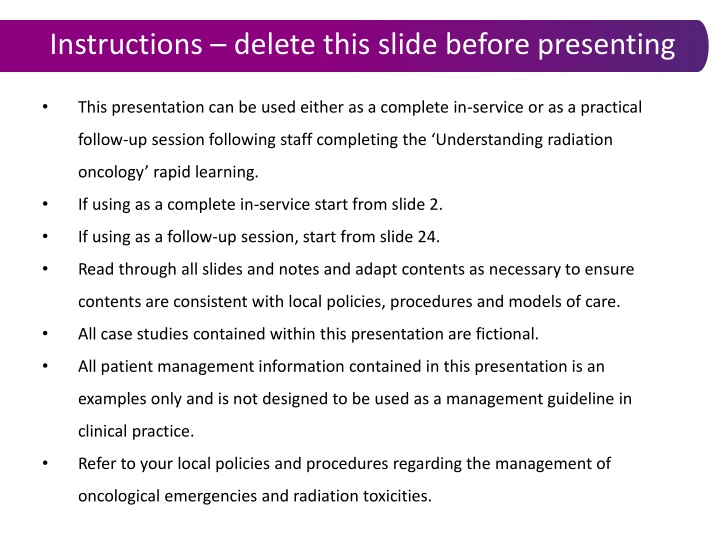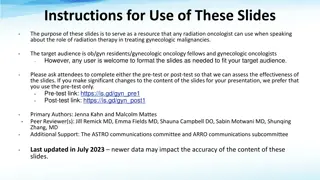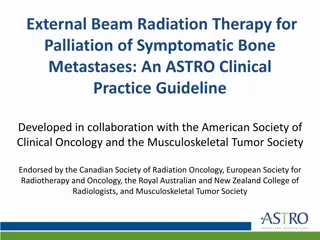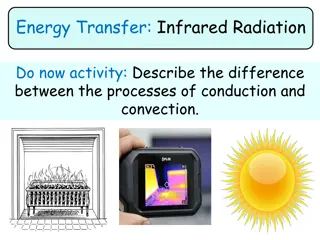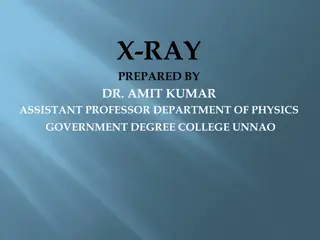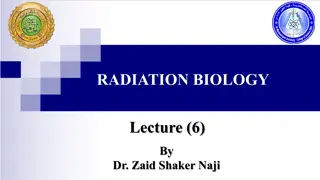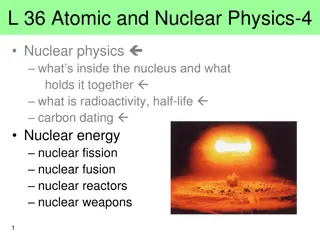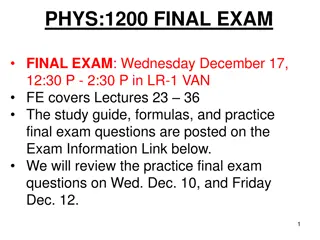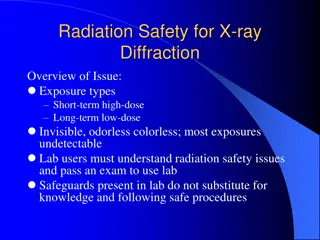Comprehensive Overview of Radiation Therapy in Oncology
Explore the world of radiation therapy in oncology with insights on indications, side effects, case studies, and treatment protocols. Understand how radiation therapy works, its various types, planning procedures, dose prescription, and patient management. Delve into the essential aspects of local treatment, cellular damage mechanisms, and practical points in collaboration with the Central Coast Cancer Centre. Enhance your knowledge through a quiz at the end of this informative session.
Download Presentation

Please find below an Image/Link to download the presentation.
The content on the website is provided AS IS for your information and personal use only. It may not be sold, licensed, or shared on other websites without obtaining consent from the author.If you encounter any issues during the download, it is possible that the publisher has removed the file from their server.
You are allowed to download the files provided on this website for personal or commercial use, subject to the condition that they are used lawfully. All files are the property of their respective owners.
The content on the website is provided AS IS for your information and personal use only. It may not be sold, licensed, or shared on other websites without obtaining consent from the author.
E N D
Presentation Transcript
Instructions delete this slide before presenting This presentation can be used either as a complete in-service or as a practical follow-up session following staff completing the Understanding radiation oncology rapid learning. If using as a complete in-service start from slide 2. If using as a follow-up session, start from slide 24. Read through all slides and notes and adapt contents as necessary to ensure contents are consistent with local policies, procedures and models of care. All case studies contained within this presentation are fictional. All patient management information contained in this presentation is an examples only and is not designed to be used as a management guideline in clinical practice. Refer to your local policies and procedures regarding the management of oncological emergencies and radiation toxicities.
Radiation therapy Introduction and practical points Developed in collaboration with the Central Coast Cancer Centre
Contents Introduction to radiation therapy 1 Indications for radiation therapy 2 Side effects 3 Case studies 4 Quiz 5
What is radiation therapy? Treatment of cancer with ionising radiation Local treatment
How does it work to treat cancer? Stops cells from replicating Causes damage to cellular DNA Direct breaks in DNA strands Indirect free radical production Cancer cells more susceptible to damage, less able to repair damage Normal cells able to repair damage and recover
Are there different types of radiation therapy? External beam radiation therapy Brachytherapy
What is involved in having radiation therapy? 2 1 Planning Initial consult 3 4 Treatment Simulation
How is radiation therapy prescribed? Radiation therapy doses are prescribed in a unit called a Gray (Gy). This is a measure of the radiation dose absorbed by the body. Gray (Gy) Prescribed doses are broken up and delivered over a number of treatments or fractions (#). Breaking the dose into fractions allows time for the body s normal cells to recover. Fractions (#) Treatment site Total dose Dose /# Fractions (#) #/day #/fortnight Right lung 60Gy 2Gy /# 30 1 9
Who can benefit from radiation therapy? Approximately 50% of all people diagnosed with cancer can benefit from radiation therapy in the management of their disease. Treatment intent Treatment setting Curative Palliative Prophylactic Emergency Sole treatment In combination with other modalities
Curative intent Treatment aim: eradication of disease Curative Definitive Adjuvant Neoadjuvant Salvage
Curative - definitive radiation therapy is the sole or primary treatment modality Systemic anti-cancer therapies may be delivered concurrently as a radiosensitiser Cancer types Prostate Cervical Head and neck Lung Anal Colorectal Oesophageal Skin Bladder Brain
Curative - adjuvant radiation therapy is delivered after primary treatments Aims to: reduce the risk of the cancer returning locoregionally improve survival. Cancer types Breast Colorectal Cervical Endometrial Oesophageal Head and neck Melanoma and skin Lung
Curative - neoadjuvant radiation therapy is delivered before surgery Aim: improving surgical outcomes e.g. shrinking the tumour to improve operability Cancer types Oesophageal Rectal Sarcoma Lung (Pancoast)
Curative - salvage Delivered after primary treatments have failed Aim: to eradicate residual disease Cancer types Prostate bed (following removal of prostate)
Prophylactic Aim: to eradicate subclinical disease in order to prevent or delay the clinical spread of disease. May provide benefit in those cancers where the pattern of disease failure is well recognised. Cancer types Prophylactic cranial irradiation in lung cancer
Palliative Aim: control symptoms, improve quality of life Indications Painful bone metastases Presence of brain metastases Skin lesion which is eroding the skin Oesophageal tumour causing dysphagia Shortness of breath from lung cancer Pain, abdominal distension from liver metastases Haematuria from bladder cancer
Emergency Aim Indications For urgent referral to radiation oncology: moderate to severe cancer pain spinal cord compression uncontrolled bleeding due to cancer superior vena cava obstruction. radiation therapy is used to shrink the tumour with the aim of: reducing pain reducing bleeding alleviating obstruction reducing compression.
Spinal cord compression Spine metastases can compress the spinal cord Swift intervention required Left untreated can lead to permanent damage and functional loss Signs and symptoms: pain that is increasing muscle weakness sensory loss numbness paraesthesia bladder and bowel dysfunction and incontinence ataxia.
Superior vena cava (SVC) obstruction Some tumours may compress the SVC May result in: breathing compromise cerebral oedema death. Signs and symptoms: oedema (head and neck region) swelling of the upper extremities dysphagia cough hoarseness dyspnoea distorted vision headaches nausea.
What treatment related toxicities are possible? Sub-acute - Weeks to months following treatment Acute during treatment usually temporary Late months following treatment may be long-term or permanent
Treatment related toxicities Localised to anatomical site or system being treated Differ according to treatment site Examples Diarrhoea (pelvis) Nausea and vomiting (abdomen or neurological) Mucositis (head and neck) Skin reaction (any site)
Radiation induced skin reactions (RISR) May present as pain, itching, redness, dryness, peeling, bleeding or ulceration of the skin. Grade 4 Grade 3 Grade 2 Grade 1
Management of RISR Management differs according to grade experienced Manage with a step up approach Unbroken skin maintain moisture levels Broken skin maintain a moist (not wet) healing environment Manage symptoms MDT care grade 4
Question 1 Why are radiation therapy doses delivered in fractions? The total dose is broken up and delivered in fractions to allow time for the body s normal cells to recover between doses.
Question 2 What patients may benefit from the use of radiation therapy in the management of their disease? Radiation therapy can be used in the management of almost all cancers as a curative treatment, to palliate symptoms or as a prophylactic treatment. Radiation therapy can be used as a sole treatment or in combination with other treatment modalities.
Question 3 Some indications for radiation therapy are considered an emergency and require an urgent referral. What are they? Moderate to severe cancer pain Spinal cord compression Uncontrolled bleeding due to cancer Superior vena cava obstruction Airway/bronchial obstruction
Question 4 What are the types of radiation therapy side effects? What is the pattern of onset for each of these? BONUS points if you give an example of each. Acute Subacute start presenting weeks or months after treatment has been completed e.g. radiation induced pneumonitis following radiation to the chest Late start presenting after the first week or two or treatment begin to resolve a few weeks after completing treatment e.g. radiation induced skin reaction. start to present months after treatment. may be long term or permanent e.g. cataracts following irradiation to the head and neck or brain region.
Question 5 Most side effects from radiation therapy are site specific or localised to the anatomical site or system being treated. What acute side effects may be experienced by patients receiving radiation therapy to the following sites? Breast Abdomen Head and neck RISR dysphagia odynophagia xerostomia dysgeusia mucositis tinnitus. RISR nausea and vomiting diarrhoea anorexia gastritis enteritis. RISR breast oedema rib pain.
Apply what youve learnt Case studies
Case study 1 Palliative Treatment - Consultation
The patient You are the ward JMO A 64yo M was admitted with metastatic prostate cancer He is now complaining of pain all over the body Your Registrar reviews the patient and requests a Rad onc consult How will you make this consult?
What might the rad onc registrar plan/suggest? Assessment Clarifies the indication/problem Prostate What is the primary cancer/diagnosis? Metastatic. Results of recent bone/PET scans show sclerotic lesions at T8 and L5 Pain in lower and upper back, legs and right ribs Where is the cancer? Where are the problem areas? Reviews the treatment Hx Yes - previously at another hospital Previous salvage RT following RP Is the patient known to any Radiation oncologist? Has the patient received radiation before? Performs a thorough clinical assessment 1 ECOG status Physical examination Pain likely referred from spine mets, ribs not tender to palpation
Plan For simulation scan today Aim to commence RT 1-3 days 20Gy/5# to the L and T spine mets Request previous treatment details check overlap with L spine What members of the MDT may you need to involve/consider? Palliative care review for pain management
Case study 2 Rad onc Emergency 1
The patient 64yo F presents with severe back pain, lower limb weakness and incontinence. Bg breast cancer The ED JMO is asked to assess the patient How should the JMO approach this case?
What might the JMO consider in their management plan? Assessment Physical examination and history 2 days (>few days complete recovery less likely) Motor strength of lower extremities decreased, sensory function reduced Yes, tenderness in lumbar spine What is the duration of symptoms? Neurological exam Vertebral tenderness? Urgent Whole spine MRI ordered immediately Demonstrates compression at L3 Imaging? Spinal Instability Neoplastic Score Score of 7 18 potentially unstable (consider surgical consult): patients scores 6
Plan Consider: glucocorticoids decompressive surgery radiation therapy Decision: Sim today plan and treat EBRT 20Gy/5#
Case study 3 Rad onc Emergency 2
The patient You are a nurse working on an inpatient ward. You are performing obs for a patient with a known lung cancer. You note that the patient is experiencing mild SOB, some difficulty swallowing and mild facial oedema What may this patient be experiencing? Potential SVC obstruction What action should the nurse take? Request immediate medical review, complete obs Consider head elevation and supplementary oxygen
Plan The patient is reviewed and sent for CT CT confirms obstruction of the SVC caused by large mediastinal mass (NSCLC) Consider: Symptomatic management Head elevation, oxygen, morphine for dyspnoea, glucocorticoids radiation therapy Chemotherapy, endovascular stenting Decision radiation therapy Sim today plan and treat 30Gy/10#
Case study 4 Radiation toxicity
The patient 65yo M with oropharyngeal ca Completed 7 weeks of definitive radiation therapy 3 days ago Admitted for pain and desquamation of skin over neck, painful mouth ulcers and dehydration The ward resident is asked to review the patient and provide management advice What may the resident consider in their assessment of this patient?
What might the resident consider in their management plan? Assessment What may this patient be experiencing? Acute toxicities of radiation therapy RISR, oral mucositis, dysphagia, xerostomia, anorexia What grade is being experienced? RISRAS tool, mucositis assessment scale, CTCAE grading tool RISR grade 3 moist desquamation and bleeding induced by minor trauma/abrasion Oral mucositis grade 3 severe pain interfering with oral intake Complete patient assessment Reduced oral intake, recent weight loss of 5kg, dehydration, reduced urinary output
Plan Admit pt monitor weight and oral intake Commence IV hydration RISR Dress neck with non-adherent absorbent dressing Monitor for signs of infection Paracetamol prn for pain Oral mucositis Regular sodium bicarbonate mouthwashes Topical anaesthetic Short active and long acting analgesia titrated to effect
Debrief Radiation therapy can be used in the management of almost all cancers as a curative treatment, to palliate symptoms or as a prophylactic treatment. Some indications for radiation therapy are considered an emergency and require an urgent referral. Side effects from radiation therapy may present as acute, sub acute or late. Radiation therapy is a local treatment and only affects the area of body being treated. Side effects will be localised.
